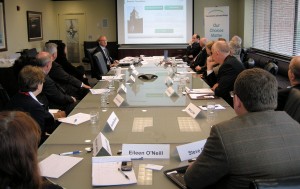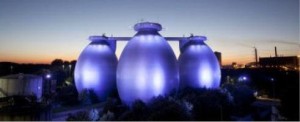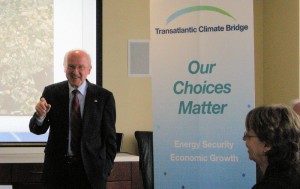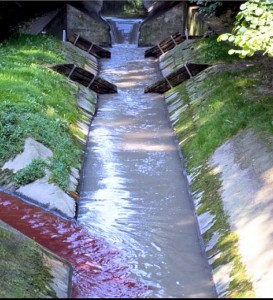
Water industry leaders gather at Water Environment Federation (WEF) headquarters in Alexandria, Va., to learn about energy innovations implemented in Germany. WEF photo/Jennifer Fulcher
Sharing knowledge and forming partnerships provides the key to the real-world implementation of innovation. That was the consensus at an April 30 meeting between German and Washington, D.C.-area wastewater sector leaders.
“The exchange between towns and the exchange with industry and science, in my opinion, that is the only way to realize innovative techniques in as many towns as possible,” said Bernd Tischler, lord mayor of Bottrop, Germany.
Tischler was one of three German leaders who presented wastewater industry innovations and cutting-edge energy management techniques being applied in the country. Ekkehard Pfeiffer, head of the River Basin Management and European Cooperation Projects Department at Emschergenossenschaft (Essen, Germany)/Lippeverband (Dortmund, Germany) and Klaus Hermann, scientific consultant for the plant and professor emeritus at Purdue University (West Lafayette, Ind.), were the other two visiting experts.

City of Alexandria Mayor William D. Eullie (third from left) talks to water industry leaders gathered at an April 30 meeting. WEF photo/Jennifer Fulcher.
Twenty-two global water industry leaders and City of Alexandria Mayor William D. Euille attended the meeting at Water Environment Federation headquarters in Alexandria, Va.
“You must be part of a regional cooperative, getting other nearby cities and towns to join in with you,” said Euille, explaining this is a lesson he learned during a tour of Germany focusing on energy sustainability, climate control, and ecosystem management strategies 4 years ago. “We can learn more from our partners across the ocean in terms of sharing their experiences and best practices with us.”

The Bottrop Wastewater Treatment Plant generates energy through solids incinceration, combined heat and power generation, gas generation and use, wind power, and hydrogen generation through electrolysis. Photo courtesy of Emschergenossenschaft (Essen, Germany).
Transforming one city at a time
Bottrop is a mining town with an active coal mine that employs 5000 people, but the mine will close in 2018. With an 8.2% unemployment rate, the government began looking to the ‘green energy’ industry to compensate for the future job loss, Tischler said.
InnovationCity Ruhr, a project of the Initiativkreis Ruhr (Essen) and the state of North Rhine–Westphalia, was launched in 2010. Bottrop was chosen for the project and will be rebuilt into a low-energy city. It will receive incentives and private investments through 2020 with the goal of cutting energy demand and carbon dioxide emissions in half. Many companies, scientific organizations, and political groups have pledged to collaborate on and invest in the project, Tischler said.
“The purpose of the project is to concentrate and apply all these products and services in one location, and this way, their operation and efficiency can be demonstrated in practice,” Tischler said.

Bernd Tischler (fourth from left), lord mayor of the city of Bottrop, Germany, and Ekkehard Pfeiffer (third from left), head of the River Bason Managememt and European Cooperation Projects Department at Emscher Genossenschaft/Lippeverband (Dortmund, Germany), present wastewater industry innovations an energy management techniques being applied in the county. Photo courtesy of Emschergenossenschaft.
The government has decided to retrofit existing buildings with energy-efficient technologies, such as more-efficient insulation, geothermal energy systems, and energy-recovery ventilation systems, Tischler said. This requires an investment of €78,000, or about $97,640, which can be financed for €2660 ($3330) per year. But already, the investment has shown a reduction of €2880 ($3605) per year in energy costs, he said.
“InnovationCity is an open project. Every company, every institution can collaborate with us,” Tischler said.
Redeveloping the Emscher River and Bottrop’s wastewater system
Bottrop’s water systems also are being transformed. Because of the mining industry, the city had to create an open sewer system, Pfeiffer said. The construction of normal sewer systems was not possible due to the mining activities,” he said.
But now, the government will phase out open sewers “and give back the river to the region’s inhabitants,” Pfeiffer said. “The region is aiming to become the greenest industry region in the world.” The project includes constructing four new wastewater treatment plants and 400 km of new underground sewers by 2017, as well as naturalizing the Emscher river system by 2020. The total budget for this work is €4.5 billion ($5.6 billion), Pfeiffer explained.
“[The project is] converting the former open wastewater creeks into lively and ecologically high-quality waterbodies,” Pfeiffer said. “This is the biggest water infrastructure project in Europe now. This is an ambitious goal to have 400 km of underground sewers ready by 2017.” But progress is being made with 225 km of these sewers completed and 90 km out of a total 350 km of waterways ecologically improved, he said.
Generating energy at wastewater treatment plants
But with increasing energy costs and the German government’s decision to stop generating nuclear energy, the government has had to rethink and realign energy supply, Pfeiffer said. So, the Emschergenossenschaft/Lippeverband water board has decided to “use its own resources to produce the energy,” he added.

The Emscher river system is being converted back into a natural waterbody. Photo courtesy of Emschergenossenschaft.
The water board manages 56 wastewater treatment plants, so “the sustainable handling of resources is an important goal,” Pfeiffer said. To do this, Pfeiffer had to work on two fronts: optimizing energy use and using renewable energy at plants. Currently, energy demand has been reduced by 14%. And, more than 60% of the demand is met by renewable energy. The goal is to be energy neutral or even to produce energy at wastewater treatment plants, he said. Plans include generating energy through solids incineration, combined heat and power generation, gas generation and use, wind power, hydrogen generation through electrolysis, and reducing energy needs by using solar drying of solids.
While wastewater treatment plants require a great deal of energy, “they offer enormous potential to produce energy using all organic sources,” Pfeiffer said. The need to revitalize the Bottrop Wastewater Treatment Plant provided the opportunity to optimize its operation and develop it into a hybrid power plant.
“In the future, the wastewater treatment plant will not only be a facility for wastewater treatment and disposal but also a place where energy is produced and used in an ecofriendly way,” Pfeiffer said. “The project is not only trend-setting for water management, it is also a … model for future cities.”
The investment in Bottrop’s redevelopment as a low-energy city has secured more than 4000 jobs, Pfeiffer said.

Klaus Hermann, scientific consultant for the lingen Wastewater Treatment Plant and professor emeritus at Purdue university (West Lafayette, Ind.), discusses energy innovations. WEF Photo/Jennifer Fulcher.
Lingen creates organic coal from wastewater
The city of Lingen also is contributing to Germany’s energy innovations.
The Lingen Wastewater Treatment Plant heats dried solids to extract and collect methane, producing 8 million kWh/year, which is roughly 70% of the electricity used by the treatment plant. It is the first medium-size plant to use the lysotherm process, which heats excess solids to 145°C in a tube system to extract methane, Hermann said.
In addition, a hydrothermal carbonization (HTC) process pressurizes solids and transforms them into coal. Burning HTC coal closes the carbon cycle; the carbon dioxide in solids was recently taken from the air and is released when the plant burns it rather than brown coal, Hermann said.
While HTC is not a new process, Hermann’s research discovered that using wastewater solids as a source is commercially viable. He explained that the process takes only 6 to 7 hours, and the product has a heating value slightly higher than brown coal “This will be the future of our plant,” Hermann said.
— Jennifer Fulcher, WEF Highlights









June 21, 2012
Featured, Technologies, WEF Resources & Efforts